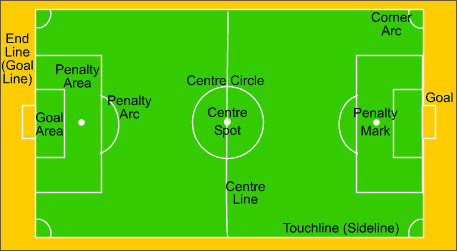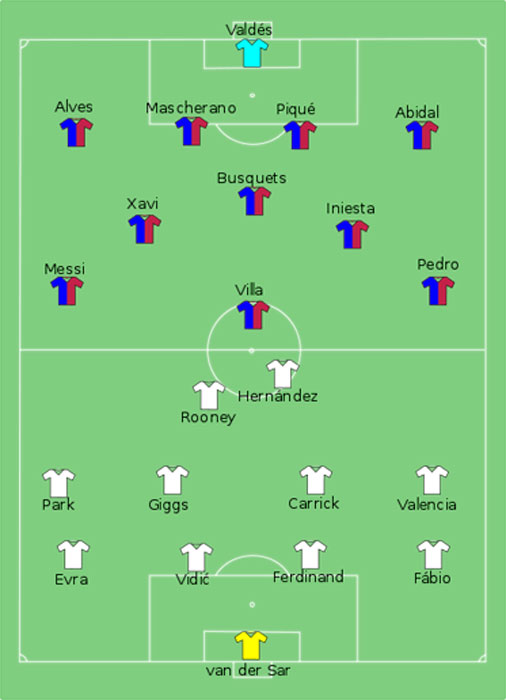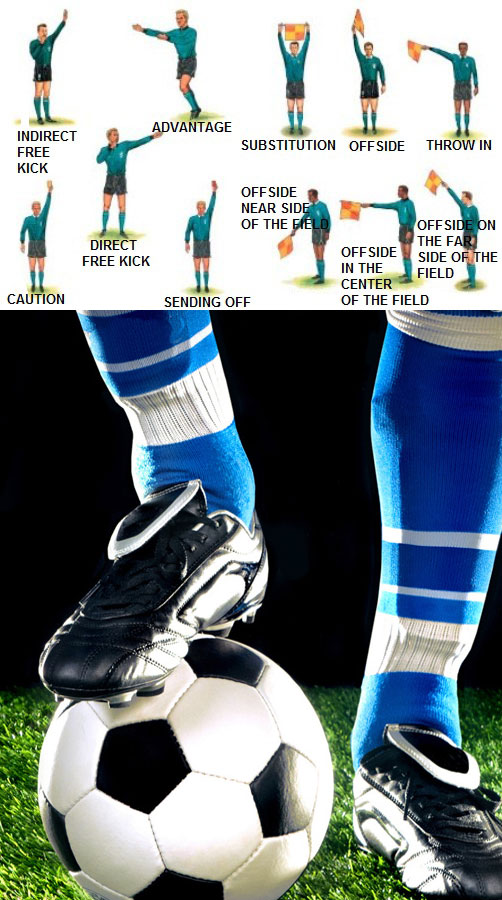ADDRESS
- Plot No-425, F-2, Sec-4, Vaishali,Ghaziabad,UP 201010
- 7asidesoccer2016@gmail.com
- www.7asidesoccer.com
- +91-9810461706, 9810929109
VIDEO
WHERE WE WORK

The rules of Soccer are officially referred to as the "Laws of the Game". The Laws of the Game are described very precisely (approximately 150 pages) on the FIFA website here. There are 17 laws in total, each one briefly summarised below.

The game can be played on either natural or artificial surfaces, the surface must be green and rectangular in shape. The two long sides of the rectangle are called touch lines and the two shorter sides are called goal lines. The field is divided in half by the halfway line.

Must be spherical, made of leather (or similar) 68-70 cm in circumference and of a certain pressure.

Two teams of no more than 11 players (one of which is the goalkeeper). A game cannot start if either team has less than 7 players.
Players must wear a jersey, shorts, stockings, shinguards and footwear.
The referee ensures the Laws of the Game are respected and upheld. Assistant Referees. There may be at most 2 assistant referees.
The game is played in 2 halves consisting of 45 minutes each. The half time interval must not exceed more than 15 minutes. At the discretion of the referee more time is allowed to compensate for any stoppage during play e.g. Due to substitutions or care and attention of injured players.
A kick-off starts play at the start of the match or after a goal. A kick-off involves one player kicking the ball, from stationary, forward from the centre spot. All players must be in their own half prior to kick-off. A coin is tossed pre-game, the team which loses the toss are awarded the kick-off to start the game whilst the team that win the toss are allowed to choose which direction they want to play. After half time the teams switch direction and the other team will kick-off. After a goal is scored, the team which conceded the goal will kick-off to restart play.

The ball is out of play once a goal has been scored or when the referee has stopped the game. The ball is in play at all other times.
The ball crosses the goal line inside the goal mouth.
It is an offence for a player to be in contact with the ball when they are closer to the opponents' goal than both the ball and the second-last opponent. The offside rule exists to ensure there are always opponents (generally the goal keeper and a defender) between a player receiving the ball and the goal. Without the offside rule, play can become boring with repeated long balls being kicked to a player stood next to the goalkeeper for an easy goal.
These are many and varied, broadly speaking it is an offence to use excessive force whilst playing the game either deliberately or undeliberately or to handle the ball (unless you are a goal keeper). The referee may show the yellow card to caution players for less serious offences and the red card for more serious offences resulting in the player being sent off. Two yellow cards are equivalent to one red card.

Are given by the referee for fouls and misconduct. A free kick can either be direct or indirect. A goal can be scored directly from a direct free kick. A goal can only be scored from an indirect free kick if it touches at least one other player first. The free kick must be taken from a stationary position with that position varying depending on whether the free kick was given inside or outside the goal area and whether it's direct or indirect. The opposing team must be a minimum of 9.15 m from the ball when the free kick is taken.
Are given against a team when they commit an offence which would normally be awarded a direct free kick inside their goal area. The ball is kicked from stationary from the penalty spot. The opposing team must be outside of the penalty area and at least 9.15 m from the ball.
Used to restart play after the whole of the ball has crossed the touch line.
Used to restart play after a goal has been scored.
Is given when the whole of the ball crosses the goal line and was last touched by a member of the defending team (and no goal was scored). A corner kick is taken from inside the corner arc closest to the point where the ball crosses the goal line. The defending team must be at least 9.15 m from the ball when the corner kick is taken.

The game shall be played by two teams, each with a maximum of 7 players including one goalkeeper. A team may dress a maximum of 13 players per game. The minimum number of players per team is 5. During a game, the goalkeeper can be replaced by another team player providing the coach has obtained prior approval from the referee and the substitution is made when the play is stopped. A player who has been expelled during the game cannot be replaced.
A player will be given a red card for:

Mandatory equipment for all players include a numbered team jersey, shorts, socks, shin guards and shoes. The equipment must be free of all items that may cause injuries to himself/herself or others, including all jewelry. Shin guards are mandatory during games and practices. For proper protection, shin guards (rubber, plastic, polyurethane or of other material), must be entirely covered by the socks. The referee must ensure that the uniforms are worn properly, hence, that all players are wearing approved footwear, shin guards and uniforms, jersey properly tucked in the shorts, and that all objects that may cause injuries (watches, earrings, Lockets, bracelets, rings, etc..) be removed. The goalkeepers shall wear a jersey of a distinguishable color from those of the other players and the referee. Should both teams wear the same color jersey, the visiting team must change their jerseys.

Referees must wear black shorts, black socks and a black jersey with a white collar (or alternate if necessary). A registered referee is appointed for each game. His/her authority and empowerment according to the rules and regulations commences on entering the game field. The referee shall check the game sheet, players’ and team personnel’s registration per froma before the game starts and refuse whoever cannot produce a duly registered per forma for the current season. The referee is responsible for the conduct of the game according to the rules and regulations. The referee will keep notes of all particular events during the game. The referee is the sole authority for keeping time, respecting regulation playing time or as previously agreed upon. Any lost time due to particular incidents shall be added to playing time. The referee has the authority to interrupt or stop any game if deemed necessary for reasons including breach of rules and regulations, continuous interference by spectators or for other reasons.
Breach with the feet Body Breach: